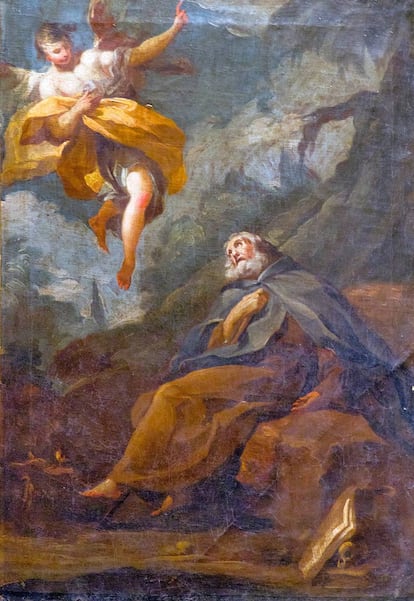A ¡®new¡¯ Goya identified at the Zaragoza Museum of Art
¡®The Ecstasy of Saint Anthony Abbott¡¯ had been in the gallery since 1925, unsigned and unidentified


Goya was always one for surprises. Last week, it was confirmed that he was the artist behind the newly restored The Ecstasy of Saint Anthony Abbott, which has been hanging in the Zaragoza Museum of Art since 1925.
Dated between 1778 and 1781, the masterpiece had previously been attributed to the brothers Manuel and Francisco Bayeu, and, at times, Goya himself. But last week, it was positively identified as the work of Aragon¡¯s most famous son during a ceremony to return the painting to Zaragoza after almost two years of analysis at the Prado Museum in Madrid.
The event was attended by Manuela Mena, the Prado¡¯s head of conservation in 18th-century painting and Goya works, and also by Almudena S¨¢nchez, a restorer of fine art who worked on the painting at the Prado between the fall of 2015 and last month. In fact, both Mena and S¨¢nchez were in daily contact with the work ¨C which is, as they say, how one really gets to know an artist.
When Mena and S¨¢nchez were first able to study The Ecstasy of Saint Anthony Abbott, they agreed that it was in good shape but needed cleaning up. According to Mena, layers of varnish had darkened the colors, preventing the strength and tone of the brush work to come through. Speaking to EL PA?S, Mena said that as recently as last week she discovered new strokes in the saint¡¯s blanket she had not noticed before. ¡°There is a light finish to them, a more liquid kind of stroke,¡± she explained enthusiastically. ¡°Very few painters manage this.¡±
There is a light finish to them, a more liquid kind of stroke. Very few painters manage this
Manuela Mena, Prado¡¯s head of conservation in 18th-century painting and Goya
The canvas consists of two pieces of fabric that have been stitched together. Recycling material was something Goya and his contemporaries often did, even those working in the royal court. But the diagonal nature of the stitching suggests the use of leftover pieces of fabric, which in turn indicates that the painting was produced for a friend and was not for sale.
Traces of wax on the canvas have led to suggestions that it came to the Zaragoza Museum from a place of prayer, but Mena dismisses this as pure conjecture, since nothing is known about the painting prior to 1925 when, according to the museum¡¯s director, Isidro Aguilera, it was donated by a Zaragoza local.
The lack of any signature may seem unusual but it was only later, when Goya became aware of his own relevance, that he began to sign his paintings. On a hunch that the painting was a Goya, staff at the Zaragoza Museum got in touch with Mena, who shared their suspicions. It wasn¡¯t until the painting had been thoroughly analyzed and worked on, however, that these were confirmed.
The real clue to its authorship was in a painting Goya finished 10 years earlier in Rome with the same title. In this version ¨C now part of a private collection ¨C he imitated the style of Italian artist Corrado Giaquinto, notable, according to Mena, in how he painted trees. The latter version was done during his tapestry era and his tree was, she says, more Goyaesque.
The Ecstasy of Saint Anthony the Abbott will take its place among works from the artist¡¯s Madrid period at the Zaragoza Museum, which holds one of the largest Goya collections in Spain after the Prado and the Academia de Bellas Artes de San Fernando in Madrid.
Only one detail remains: to update the Culture Ministry¡¯s online catalogue, Ceres, which contains information on most collections belonging to state museums.
English version by Heather Galloway.
Tu suscripci¨®n se est¨¢ usando en otro dispositivo
?Quieres a?adir otro usuario a tu suscripci¨®n?
Si contin¨²as leyendo en este dispositivo, no se podr¨¢ leer en el otro.
FlechaTu suscripci¨®n se est¨¢ usando en otro dispositivo y solo puedes acceder a EL PA?S desde un dispositivo a la vez.
Si quieres compartir tu cuenta, cambia tu suscripci¨®n a la modalidad Premium, as¨ª podr¨¢s a?adir otro usuario. Cada uno acceder¨¢ con su propia cuenta de email, lo que os permitir¨¢ personalizar vuestra experiencia en EL PA?S.
?Tienes una suscripci¨®n de empresa? Accede aqu¨ª para contratar m¨¢s cuentas.
En el caso de no saber qui¨¦n est¨¢ usando tu cuenta, te recomendamos cambiar tu contrase?a aqu¨ª.
Si decides continuar compartiendo tu cuenta, este mensaje se mostrar¨¢ en tu dispositivo y en el de la otra persona que est¨¢ usando tu cuenta de forma indefinida, afectando a tu experiencia de lectura. Puedes consultar aqu¨ª los t¨¦rminos y condiciones de la suscripci¨®n digital.








































